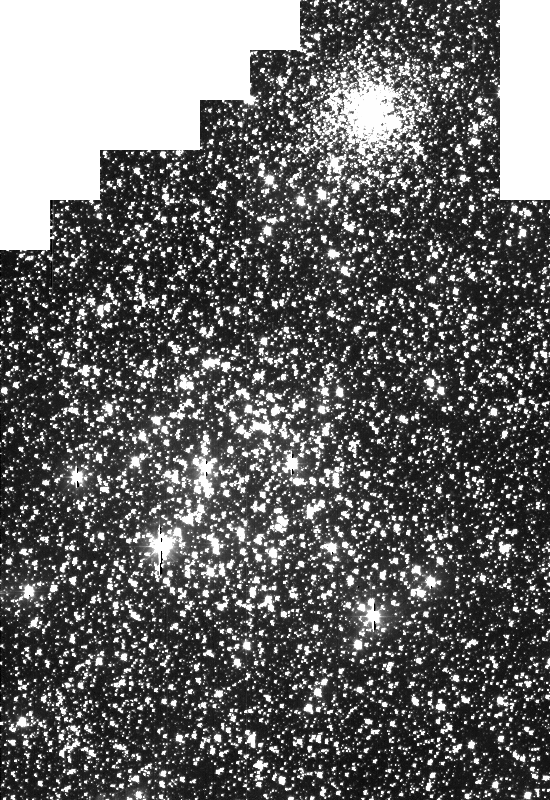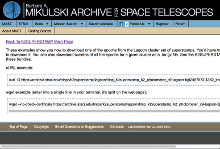|
|||||||||||||||||||
|
|
|||||||||||||||||||
K2SUPERSTAMP
Cody et al. 2018, RNAAS, 2a, 25Source code available on GitHub.
Introduction |
Description of Data Products |
Data Access |
Download README |
Introduction
The K2SUPERSTAMP project consists of image data on open clusters and other crowded regions observed by the NASA K2 Mission. Clusters include M35, M67, Ruprecht 147, and NGC 6530-- the Lagoon Nebula Cluster (referred to here as the Lagoon). Also observed were five regions of the Galactic bulge. While data for these regions were previously released by K2, it consisted of small (~50x50) target pixel file stamps. In this release, the K2SUPERSTAMP team have stitched together all small stamps for each region to create one larger image for every epoch, and subsequently fit a world coordinate system (WCS) solution to each resulting FITS file.
With these products it is now possible to identify any and all stars in these open cluster regions via their right ascension and declination. Most stars that fell across the edge of the target pixel files now have spatially continous data. The data is flux in counts (e-/s). For M67, Ruprecht 147, and the bulge regions, it has been background subtracted (background was not estimated by the K2 pipeline for M35 and the Lagoon). Each file corresponds to a single timestamp at the 30 minute long cadence of K2, and may be read in via standard FITS handling programs (e.g. IRAF or Python/astropy). This format enables the production of time series photometry for cluster stars, and the resulting light curves are now being used to study stellar rotation in M35 (Cody et al. 2019, in prep.) and M67 (Giampapa et al. 2019, submitted) as well as pre-main sequence star variability in the Lagoon (Cody et al. 2019, in prep.)
Version 2
For version 2, superstamp images were stitched together using k2mosaic, and also include any target pixel file data that fall within the channel. A World Coordinate System (WCS) was then added and headers edited so as to be compatible with Kepler/K2 and TESS full frame images, using the codes posted at this GitHub repo.
Description of Data Products
Open Cluster Superstamps
The superstamps are sorted into subdirectories based on the cluster name or channel (in the case of bulge fields). For the open clusters, each cadence's file name begins with "hlsp_k2superstamp_k2_photometer", followed by this format:
where:
- c<#> is the K2 Campaign this superstamp came from, e.g., "c9"
- <cluster> is the name of the cluster: "lagoon", "m35", "m67", or "ruprecht147"
- <tstamp> is the BJD time of the mid-point of the epoch
- <v#> is the version number, either "v1" or "v2"
The images are stored in the first extension, along with a number of header keywords. Many of the keywords are inherited from the target pixel files, and the values are modified where needed to apply to the superstamp. These keywords are described in the Kepler Archive Manaual. The timestamps in the header are defined as follows:
- DATE-OBS: UTC date and time of the beginning of exposure
- DATE-END: UTC date and time of the end of exposure
- TSTART: BJD time of the beginning of exposure
- TSTOP: BJD time of the end of the exposure
- MIDTIME: BJD mid-time of the exposure
Campaign 9 Galactic Bulge Superstamps
For the Campaign 9 bulge fields, superstamps are sorted into subdirectories based on their detector channel. Each cadence's file name begins with "hlsp_k2superstamp_k2_photometer", followed by this format:
where:
- c<#> is the K2 Campaign number, which is either "91" for the first half of Campaign 9 or "92" for the second half
- <channel<#>> indicates which channel was observed
- <tstamp> is the BJD time of the mid-point of the particular epoch
A primary header contains basic information about the observatiosn, and images and their associated time-specific information are stored in the second ("image") extension. A third extension holds an uncertainty image, while a fourth extension contains an empty cosmic ray table. Timestamps are the same as listed above for the cluster fields, except for the addition of the following:
- MJD-BEG: TSTART as modified barycentric Julian date
- MJD-END: TSTOP as modified barycentric Julian date
Data Access
Bundles (.tar.gz for each cluster directory) |
cURL or wget scripts per cluster |
|
|
|




 Follow Us
Follow Us

